NO TIME TO DIE Countdown: THUNDERBALL Revisited
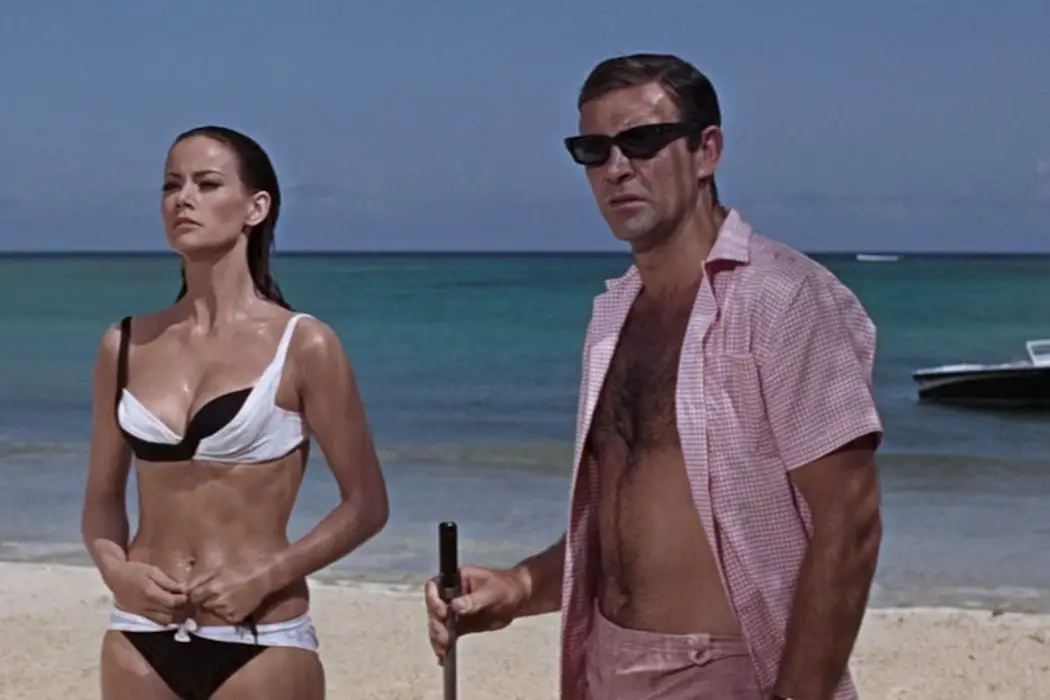
Movie lover & Los Angeles-based writer. BA in Film Criticism…
In the No Time To Die Countdown, Jake Tropila takes a look back at every Bond film – official and unofficial – in anticipation of the release of the latest entry.
For many viewers attempting their first “Bond-through,” this is likely where they’ll hit their first snag. Not to say that Thunderball is a bad picture; on the contrary, it’s actually quite excellent and makes a strong case for being one of the most criminally undervalued films in the series. It also plays an important role in Bond’s enduring legacy, and it’s one I grow fonder and fonder of with each subsequent revisit.
But coming off the heels of the almighty Goldfinger, it is fair to say that this film lacks the sheer excitement of its predecessor. All of the proper elements are in place – diabolically villain plot, exotic locales, beautiful women, nifty gadgets, a pool filled with man-eating sharks – but Thunderball fails to conjure up an image as memorable and striking as Jill Masterson painted gold and lying dead in the hotel bedroom. Furthermore, the film runs about twenty minutes longer than Goldfinger, and that extra heft clearly shows; the pacing is clearly not this film’s strong suit.
A lot of the blame for Thunderball’s flaws is often aimed squarely at its many underwater sequences. Despite looking downright tremendous and being a strong technical achievement in the 1960s cinematography, they do run overlong, and along with their protracted length, this new environment renders movement totally sluggish. There’s also the matter of the film’s messy legal battles that occurred off-screen, which we’ll get to in greater detail.
But for me, I think this is the platonic ideal of a 007 hangout picture. Having run through the franchise several times over, I tend to gravitate towards the longer entries with more relaxed and deliberate pacing. They do their job remarkably well and are in no rush to get it done. Plus, Thunderball exudes a nice “Bond on vacation” vibe that I very much enjoy basking in. Without further ado, let’s slip on our wetsuits and dive into the fresh waters of 1965 to find out why.
Holding the world hostage
007 enters the world of cinemascope, which means it’s time for an updated gunbarrel sequence! Sean Connery finally takes center stage here, eschewing stuntman Bob Simmons’s leap-and-shoot technique for a swifter turn-and-shoot, setting the standard for all Bond’s to follow. Our pre-title sequence opens with a nice fake-out: the initials “J.B.” on the casket are meant not for James Bond, but Jacques Bouvar, a notorious agent of SPECTRE (remember them?). Bond is in attendance to ensure the job is done.
Alas, Bouvar, alive and well and disguised as his own grieving widow, gives himself away by opening his own car door. This of course immediately rouses suspicion in Bond – how dare a woman appear to open her own car door in the mid-1960s? We get the perverse sight of Bond appearing to punch a woman square in the face (before the revelation that she is a he, natch), and a destructive brawl ensues. It’s not quite From Russia with Love but it is a serviceable fight, and after Bond puts the doomed agent down for good he summarily escapes in one of his most outlandish gadgets yet: a jetpack. A shock, a fight, and an over-the-top gadget make for a satisfyingly rudimentary sequence. The water jets shooting out of the back of Bond’s Aston Martin dissolve into the credit sequence, where Tom Jones is queued up to give your sound system a workout.
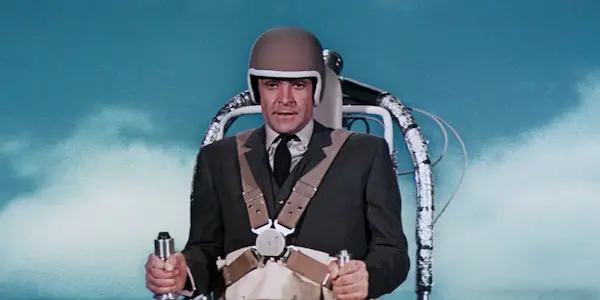
One gets the sense that producers Harry Saltzman and Cubby Broccoli were desperately trying to Shirely Bassey-esque lightning in a bottle, and our title song here does echo a lot of the same beats, right down to Jones’s belter of a performance. “Thunderball” may not have the lasting radio power that “Goldfinger” has, but it gets the job done (I particularly enjoy the instrumental beats between these lyrics: “And he strikes – dun dun dun dun DUN – like Thunderball!”). Legend has it that, like Bassey, Jones fainted after delivering that last note in the recording booth. I believe it.
Speaking of replicating success, it’s crucial to note that at this point in Bond history, the series was now a bona fide global phenomenon, and Thunderball would go on to be the highest-grossing film in the franchise in the United States (only after adjusting for inflation: it earned the 2020 equivalent of $540 million domestic dollars in 1965, thus paving the way for future blockbusters like Jaws and Star Wars). Thunderball itself might not receive all the love in the world, but it firmly established that Bond was capable of capturing audiences everywhere, and the series was here to stay.
Back to our plot. Following the pre-title sequence, we get a rare SPECTRE boardroom meeting, a sequence I relish for several reasons. First, all of the attendees are reading off their accomplishments in terrorism with all the enthusiasm of a banal quarterly office meeting – a political assassination here, 40 million yen in blackmail there. It’s also a plain delight to see everything played so dryly. We’re also treated to more glimpses of the elusive Number One, his fine Persian cat, and his ruthless business practices. All I can say is it’s a damn shame about the agent who attempts to keep a little of his illicit earnings on the side; he’s promptly electrocuted in his own chair, and his body disposed of through a contraption built in the floor (Where does that lead to, exactly? Garbage chute? Incinerator? Best not to wonder…).
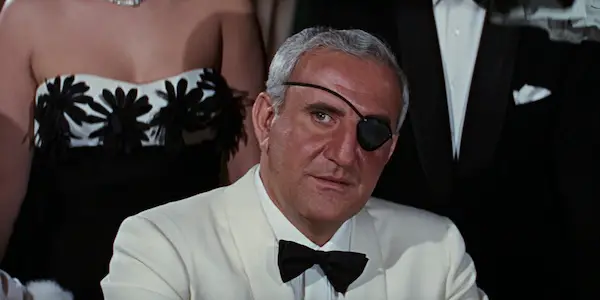
SPECTRE’s Number Two is Emilio Largo (Adolfo Celi), and he comes forward with a corker of a plan: steal two nuclear missiles from a routine NATO flight and use them to hold the world hostage for ransom money. Proper evil, if you ask me. Two essential players in Largo’s scheme are currently recuperating at the Shrublands health clinic, where Bond is also recovering from his encounter with Bouvar. The two players are Count Lippe, SPECTRE’s Number Four, and Angelo Palazzi, a pilot hired to impersonate the real pilot of the NATO flight and hijack the plane.
They encounter Bond several times during their stay, and he’s immediately onto them (Lippe’s hand tattoo gives him away). While I do enjoy Bond being playfully antagonistic to the enemy prior to the final showdown, the entire “death by traction” bit plays more goofy than intense, but I chalk that up to the poor execution in filmmaking. For added discomfort, Bond extorts his nurse out of her uniform and into bed so she can avoid punishment. Say what you will about Dr. No: his instincts about Bond being a perfect fit for SPECTRE were right on the money.
The overall endgame of SPECTRE’s plot is relatively straightforward, but the machinations to get there are almost unnecessarily convoluted. Let’s break it down: Largo creates the scheme to steal two nuclear bombs from a scheduled NATO flight. A man named Angelo Palazzi has undergone extensive facial reconstruction surgery to resemble François Derval, the true NATO pilot. Derval, meanwhile, has been seduced by SPECTRE assassin Fiona Volpe (Luciana Paluzzi) to gain intel to the flight. Once Angelo’s surgery is complete, he murders Derval and takes his place in the flight (but not before demanding more money from SPECTR – big mistake). Angelo kills the rest of NATO crew mid-flight and crashes the plan in the ocean, where Largo and his men retrieve it from an extensive scuba diving trip. The bombs are then loaded onto Largo’s ship, the Disco Volante, and ransom calls to the US and UK are made. Phew!
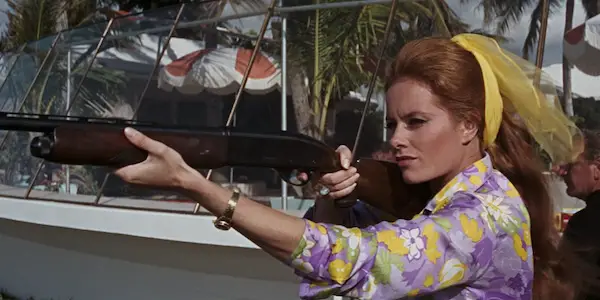
Largo’s plan nearly goes off without a hitch. Angelo’s last-minute extortion proves to be his downfall and is left to drown in his pilot seat at the bottom of the ocean. Likewise, Count Lippe, the man who hired Angelo, is assassinated by Volpe. Bond, who had been casually tailing these two, finds that his leads are now all but dead.
Once the ransom demand is made, we get another rare meeting: a meeting of the 00’s with M. Bond arrives late (in a small detail I adore, he sits in the seventh chair from the left in MI6’s decadent conference room) and is handed a file for “Operation: Thunderball.” The mission to retrieve the nukes is on.
Swimming with sharks, on-screen and off
Quite a laborious set-up, no? If you’ve made it this far, I commend your patience. Thunderball can be a slog for first-timers. Luckily, things perk up mightily once Bond arrives in the Bahamas, chasing the one lead that caught his eye: Domino Derval (Claudine Auger), the doomed pilot’s sister. Bond’s instincts prove to be correct once again: she’s under the thumb of Largo as his mistress. The plot thickens.
She may be lacking a silly name, but Domino should be remembered as one of the best Bond girls. Certainly as one of the strongest, character-wise. What makes her so compelling is that she feels very real; there are genuine pangs of heartache once she discovers the fate of her brother, and her forced commitment to Largo is a gripping part of the narrative. That Largo gets his comeuppance at the hands of her (and not Bond) makes for a very satisfying character arc. Credit to Auger’s wonderful performance for breathing life into the character; her enthusiasm is infectious on-screen.
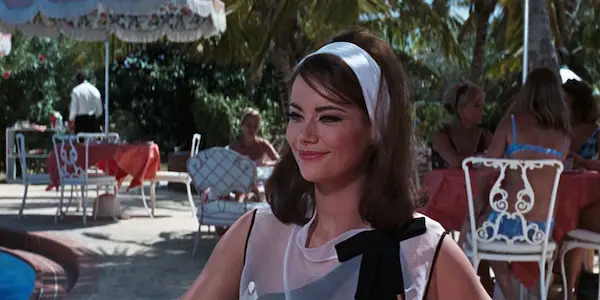
For how dastardly his deeds are, Largo makes for a fairly boilerplate villain. He’s certainly not a nice man, but he’s little more than an eyepatch in a suit. I suppose this is by design; Thunderball is directed by Terence Young, making this his third and final Bond film, and for all its excesses there are genuine attempts to hark back to the spy days of Dr. No and From Russia with Love. Consider the sequence where Bond returns to his hotel room and listens to a tape recorder he had planted in his own room to deduce the location of an assailant that snuck in – that’s the good stuff right there.
We also get our third iteration of Felix Leiter, played here by Rik Van Nutter. As far as quality Leiter’s go, this guy gets criminally underlooked in the Bond canon. He’s not as suave as Jack Lord, but he is as capable, and he does hang around for a lot longer, essentially Bond’s right-hand man for the entire second half of the film. Leiter’s appearances are typically brief, but I was surprised to rediscover how proactive Van Nutter is. Until No Time to Die is released, this is the closest we have to a proper Bond and Leiter buddy cop movie, and I think that is worthy of celebration.
Rounding out our cast and stealing the show outright is Fiona Volpe. The fiery redhead of SPECTRE, Volpe relishes her line of work, operating with a gusto and energy that reverberates through Paluzzi’s crackling performance. She’s an immense highlight on-screen, and the movie does diminish once she departs the film (through a literal dance of death with Bond).
Two key sequences in Connery’s tenure exist in Thunderball. The first involves swimming with some sharks. While infiltrating Largo’s compound, Bond and an unlucky goon are sealed beneath the surface of a pool while Largo unleashes some hungry foes to eliminate the spy. While drowning is not an imminent danger to Bond (he was issued a re-breathing device, courtesy of Q), the sharks certainly are, and poor Connery had to shoot the scene without the knowledge that they’d be in the pool with him. That look of fear on his face when they first appear is very real.
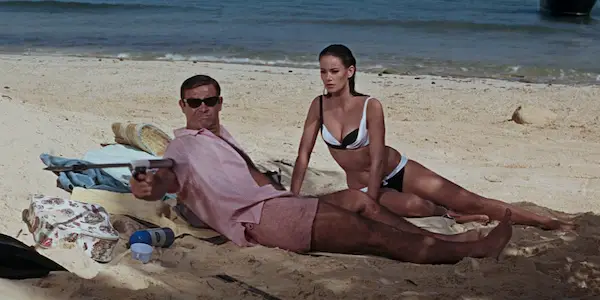
The second sequence arrives at the Junkanoo celebration. Bond, on the run from Volpe and her men, hides out in a colorful parade of floats and festive dancers. What’s significant here is that Bond is unarmed, outgunned, and wounded, thus made vulnerable to danger. This is no easy feat, as the superspy we know and love is often depicted as practically an immortal know-it-all. Here, he must use his wiles to escape (this is where we lose Fiona Volpe – a shot in the back meant for Bond). Kudos to Connery’s fine performance for selling the tension so well; it’s rare for him to look anything other than unstoppable.
Thunderball is perhaps most infamous for its many legal disputes that occurred behind the scenes. Some background: in 1958, when Ian Fleming began talks of developing a script for a Bond film, he teamed up with British playwright Jack Whittingham and Irish screenwriter Kevin McClory to produce a story. The trio kicked around several ideas, with Fleming in particular fascinated by the idea of a Bond underwater adventure, but nothing ever coalesced and the writing partnership dissolved.
Cut to 1961, and Thunderball the book has just been published, with Fleming utilizing some of the ideas that originated from his meetings with the other two. McClory immediately went on the offensive and took Fleming to court, believing the rights to Thunderball to be his. Due to his failing health, Fleming settled out of court, and Broccoli and Saltzman granted McClory the sole producer credit as well as a “Story By” credit (shared with Fleming and Whittingham) for Thunderball the film, and even allotted him screen rights to the film’s story, characters, and plot, on the condition that he did not produce his own feature film version of Thunderball for at least ten years.
If you’re still with me after all that, dear reader, I salute you. Despite these numerous deals and settlements, McClory would become a perpetual thorn in the Bond producers’ sides for the next four decades, resulting in his own production of Thunderball to be made (1983’s Never Say Never Again) and the organization of SPECTRE all but disappearing from the official franchise out of fear of future disputes (2015’s Spectre is effectively a celebration of the reclamation of rights to the proper owners). But Bond would endure; it was bigger than SPECTRE, and it was certainly bigger than McClory.
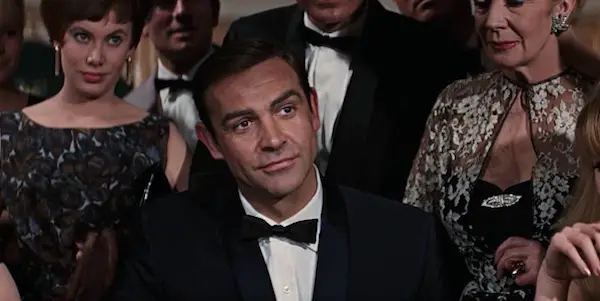
Back to our film. Bond’s locates the bombs through impeccable spy work, and Thunderball climaxes with our first of many “army versus army” encounters, pitting the U.S. Navy against SPECTRE’s marine unit in a battle that features lots and lots of fired spearguns. Despite earning a lot of grief from fans, I have not mentioned much about the underwater sequences because they don’t really bother me like they do others. They still look astonishing, and movement is not quite as diminished, particularly in the final battle, which is actually pretty thrilling, especially once Bond enters the fray and starts knifing the tubes in SPECTRE’s scuba tanks. I could watch that go on for ages.
Back on the surface, the Disco Volante goes up in a blaze of glory, but not before Domino spears Largo in the back. The two escape and are rescued via skyhook (which Christopher Nolan blatantly stole from here for his use in The Dark Knight). The bombs are recovered, the world is saved, and the lovers fly away in each other’s arms.
Conclusion
So, that’s Thunderball, in all of its bloated glory. If you have not seen it, or are deterred from revisiting it based on bad memories of the underwater sequences, I urge you to give it another look. The film moves at a leisurely pace, but it still exudes Classic Bond and features some of the finest spy work in the series to date. Once you get through that first act, it’s all good times and smooth sailing.
In our next entry, we veer off course into uncharted territory: we’ll be covering the first of our two unofficial entries, starting with the infamous James Bond spoof. The No Time to Die countdown will return with 1967’s Casino Royale.
What do you think? Is Thunderball better than the reputation that precedes it? Let us know in the comments below!
Watch Thunderball
Does content like this matter to you?
Become a Member and support film journalism. Unlock access to all of Film Inquiry`s great articles. Join a community of like-minded readers who are passionate about cinema - get access to our private members Network, give back to independent filmmakers, and more.
Movie lover & Los Angeles-based writer. BA in Film Criticism & Media Theory from CSU Northridge. Unofficial Bond ally. Rhymes with “tequila.”













